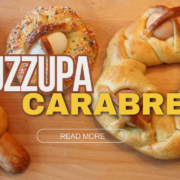Exploring the Delicious Tradition of Pizzagaina: A Savory Italian Treat
In the realm of Italian cuisine, there exists a treasure trove of culinary delights, each bearing a rich history and a unique flavor profile. Among these treasures is the beloved Pizzagaina, a traditional savory pie that holds a special place in Italian households, particularly during festive occasions like Easter. Also known as Pizza Rustica or Easter Pie, Pizzagaina is a delectable amalgamation of meats, cheeses, and eggs encased in a flaky pastry crust. Join us on a culinary journey as we delve into the origins, ingredients, and preparation of this timeless Italian delicacy.
View this post on Instagram
Origins of Pizzagaina:
Pizzagaina traces its roots back to the rustic kitchens of Southern Italy, where it originated as a hearty peasant dish. Over time, it evolved into a symbol of abundance and celebration, often enjoyed during religious festivals and family gatherings. The tradition of making Pizzagaina has been passed down through generations, with each family adding its own unique twist to the recipe. Today, this savory pie continues to evoke nostalgia and culinary heritage, both in Italy and among Italian communities around the world.
View this post on Instagram
Ingredients: The beauty of Pizzagaina lies in its versatility, allowing for variations in ingredients based on personal preference and regional influences. However, the core components typically include:
- Pastry Dough: A flaky, buttery crust forms the foundation of Pizzagaina. Traditional recipes call for a simple pastry dough made from flour, butter, salt, and water, though some modern adaptations may incorporate eggs or baking powder for added richness and texture.
- Meats: Pizzagaina traditionally features a medley of cured meats such as prosciutto, salami, and pepperoni. These savory meats lend depth of flavor and richness to the pie, complementing the other ingredients perfectly.
- Cheeses: A variety of cheeses are layered within the Pizzagaina, contributing creamy textures and savory notes. Common choices include ricotta, mozzarella, parmesan, and pecorino romano, each adding its own distinctive flavor profile to the dish.
- Eggs: Eggs play a crucial role in binding the ingredients together and providing structure to the pie. They are typically beaten and mixed with the cheese and meat filling before being poured into the pastry crust.
- Seasonings: Aromatic herbs and spices such as black pepper, parsley, and oregano are often used to season the filling, enhancing its depth of flavor and adding a touch of Mediterranean flair.

Ingredients for Pizzagaina
Preparation: The preparation of Pizzagaina is a labor of love, requiring patience and attention to detail. The process typically involves the following steps:
- Prepare the Pastry Dough: Begin by making the pastry dough, combining flour, butter, salt, and water until a smooth, elastic dough forms. Divide the dough into two portions, one for the bottom crust and one for the top.
- Prepare the Filling: In a large mixing bowl, combine the cured meats, cheeses, beaten eggs, and seasonings, stirring until well incorporated. Adjust the seasoning to taste, ensuring a harmonious balance of flavors.
- Assemble the Pie: Roll out the bottom crust and line a greased pie dish with it, ensuring an even layer that covers the bottom and sides of the dish. Spoon the filling into the pastry-lined dish, spreading it out evenly. Roll out the top crust and place it over the filling, crimping the edges to seal the pie.
- Bake to Perfection: Preheat the oven to the specified temperature and bake the Pizzagaina until the crust is golden brown and the filling is set and slightly puffed. Allow the pie to cool slightly before slicing and serving, allowing the flavors to meld together beautifully.
Pizzagaina embodies the essence of Italian culinary tradition, serving as a delightful symbol of family gatherings and festive celebrations. Whether it’s enjoyed during Easter festivities or as a comforting meal any time of the year, this savory pie offers a flavorful journey through Italy’s culinary landscape. So, why not honor tradition and savor the timeless pleasure of Pizzagaina?

 True Italian
True Italian

 True Italian
True Italian

 True Italian
True Italian
 True Italian
True Italian
 True Italian
True Italian
Leave a Reply
Want to join the discussion?Feel free to contribute!